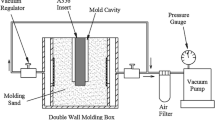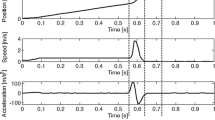Abstract
The high pressure die casting (HPDC) process has achieved remarkable success in the manufacture of aluminum–silicon (Al–SI) alloy components for the modern metal industry. Mathematical models are proposed for the modeling and analysis of the effects of machining parameters on the performance characteristics in the HPDC process of Al–SI alloys which are developed using the response surface methodology (RSM) to explain the influences of three processing parameters (die temperature, injection pressure and cooling time) on the performance characteristics of the mean particle size (MPS) of primary silicon and material hardness (HBN) value. The experiment plan adopts the centered central composite design (CCD). The separable influence of individual machining parameters and the interaction between these parameters are also investigated by using analysis of variance (ANOVA). With the experimental values up to a 95% confidence interval, it is fairly well for the experimental results to present the mathematical models of both the mean particle size of primary silicon and its hardness value. Two main significant factors involved in the mean particle size of primary silicon are the die temperature and the cooling time. The injection pressure and die temperature also have statistically significant effect on microstructure and hardness.
Similar content being viewed by others
References
Hatch JE (1984) Aluminum: properties and physical metallurgy. ASM, Metals Park, Ohio
Gruzleski JE, Closset BM (1990) The treatment of liquid aluminum–silicon alloys. AFS, Des Plaines, Illionis
Miller WS, Zhuang L, Bottema J, Wittebrood AJ, Smet PD, Haszler A (2000) Recent development in aluminum alloys for the automotive industry. Mater Sci Eng A 280:37–49
Grum J, Kisin M (2003) Influence of microstructure on surface integrity in turning-part I: the influence of the size of the soft phase in a microstructure on surface-roughness formation. Int J Mach Tools Manuf 43:1535–1543
Grum J, Kisin M (2003) Influence of microstructure on surface integrity in turning— part II: the influence of a microstructure of the workpiece material on cutting forces. Int J Mach Tools Manuf 43:1545–1551
Yue TM, Chadwick GA (1996) Squeeze casting of light alloys and their composites. J Mater Process Technol 58:302–307
Syrcos GP (2003) Die casting process optimization using Taguchi methods. J Mater Process Technol 135:68–74
Maeng DY, Lee JH, Won CW, Cho SS, Chun BS (2000) The effects of processing parameters on the microstructure and mechanical properties of modified B390 alloy in direct squeeze casting. J Mater Process Technol 105:196–203
Laukli HI, Gourlay CM (2005) Effects of Si content on defect band formation in hypoeutectic Al–SI die castings. Mater Sci Eng A 413–414:92–97
Sevik H, Kurnaz SC (2006) Properties of alumina particulate reinforced aluminum alloy produced by pressure die casting. Material & Design 27(8):676–683
Maleki A, Niroumand B, Shafyei A (2006) Effects of squeeze casting parameters on density, macrostructure and hardness of LM 13 alloy. Mater Sci Eng A 428:135–140
Dey AK, Poddar P, Singh KK, Sahoo KL (2006) Mechanical and wear properties of rheocast and conventional gravity die cast A356 alloy. Mater Sci Eng A 435–436:521–529
Wang YC, Li DY, Peng YH, Zeng XQ (2007) Numerical simulation of low pressure die casting of magnesium wheel. Int J Adv Manuf Technol 32(3–4):257–264
Myers RH, Montgomery DH (1995) Response surface methodology. Wiley, New York
Grum J, Slabe JM (2004) The use of factorial design and response surface methodology for fast determination of optimal heat treatment conditions of different Ni-Co-Mo surface layers. J Mater Process Technol 155–156:2026–2032
Ozcelik B, Erzurumlu T (2005) Determination of effecting dimensional parameters on warpage of thin shell plastic parts using integrated response surface method and genetic algorithm. Int Commun Heat Mass Transf 32:1085–1094
Kurtaran H, Erzurumlu T (2006) Efficient warpage optimization of thin shell plastic parts using response surface methodology and genetic algorithm. Int J Adv Manuf Technol 27:468–472
Puri AB, Bhattacharyya B (2005) Modeling and analysis of white layer depth in a wire-cut EDM process through response surface methodology. Int J Adv Manuf Technol 25:301–307
Kansal HK, Singh S, Kumar P (2005) Parametric optimization of powder mixed electrical discharge machining by response surface methodology. J Mater Process Technol 169:427–436
Oktem H, Erzurumlu T, Kurtaran H (2005) Application of response surface methodology in the optimization of cutting conditions for surface roughness. J Mater Process Technol 170(1–2):11–16
Lin BT, Jean MD, Chou JH (2007) Using response surface methodology with response transformation in optimizing plasma spraying coatings. Int J Adv Manuf Technol 34:307–315
Author information
Authors and Affiliations
Corresponding author
Rights and permissions
About this article
Cite this article
Chiang, KT., Liu, NM. & Tsai, TC. Modeling and analysis of the effects of processing parameters on the performance characteristics in the high pressure die casting process of Al–SI alloys. Int J Adv Manuf Technol 41, 1076–1084 (2009). https://doi.org/10.1007/s00170-008-1559-5
Received:
Accepted:
Published:
Issue Date:
DOI: https://doi.org/10.1007/s00170-008-1559-5




